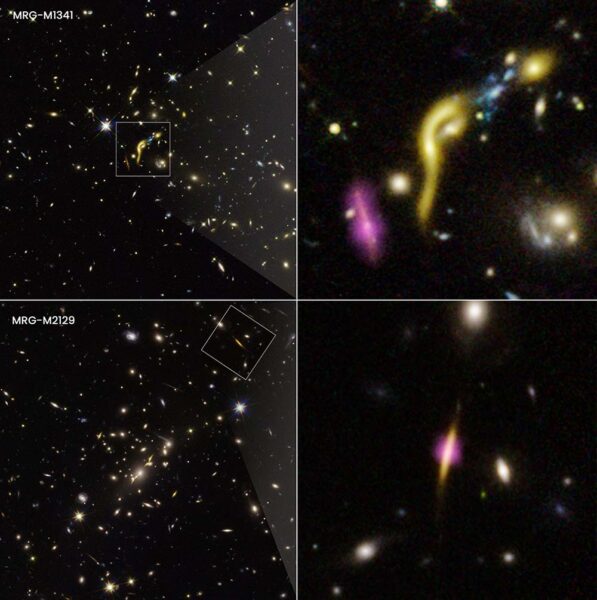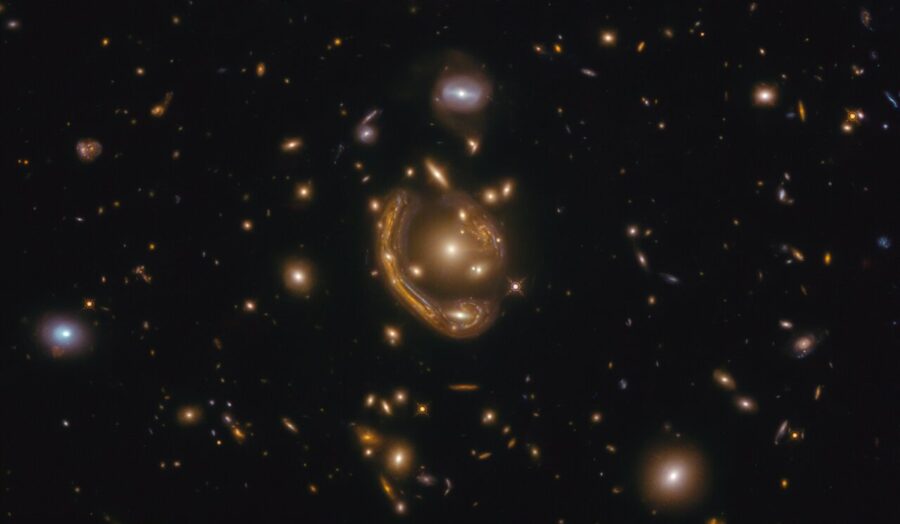Astronomers use cosmic magnifying lenses to peer into the universe’s distant past.
The universe provides its own magnifying lenses: The combined heft of giant groups of galaxies (and their retinues of hot gas and dark matter) provides the gravitational force necessary to bend the light of fortuitously aligned background galaxies. Via these chance line-ups, astronomers can peer at galaxies in the early universe that would otherwise be out of reach of current technology.
Two studies released in the past week have made use of gravitational lenses to provide a new window on galaxy growth — and stagnation.
Massive Galaxies Live Fast, Die Young
Six massive galaxies hailing from a universe between 2 and 4 billion years young have already outlived their glory days. These galaxies had cranked out stars early on, but now observations from the Atacama Large Millimeter/submillimeter Array (ALMA) in Chile show that, even as the universe as a whole was still bustling with activity, these galaxies were churning to a halt.

NASA / ESA / Katherine E. Whitaker (UMass); Image processing: Joseph DePasquale (STScI)
Kate Whitaker (University of Massachusetts, Amherst) and colleagues studied dust as a proxy for the cold hydrogen (H2) gas that makes up stars. While the dust glows at infrared wavelengths, it has to traverse the expanding universe and stretches to millimeters long as it does so. Whitaker's team translated the millimeter-wavelength glow that ALMA captured to infer first the amount of dust and then the amount of associated gas. And they found there was precious little of it.
Why these galaxies ran out of gas is still a mystery, but what we do know is that it's unlikely they can just take a walk to the station to get more. Hot gas in galaxy halos ought to cool and fall in, but this doesn't typically happen — stellar winds, black hole feedback, and other mechanisms may block the replenishment. And the observations taken by Whitaker's team show those mechanisms may already be at work by the time the universe is just a few billion years old.
Read more in the Hubble press release and in the September 23rd Nature (preprint available here).
"Molten Ring" in Fornax, the Furnace

ESA / Hubble & NASA / S. Jha; Acknowledgement: L. Shatz
Rarely, a gravitational lens lines up just about perfectly, so that a background galaxy's light passing through it bends around into a ring. The largest and one of the most complete so-called Einstein Rings ever observed comes from a spiral galaxy residing during the universe's heyday, new research says.
The galaxy, dubbed "Molten Ring" for its appearance and placement on the sky, can be found in the southern constellation Fornax, the Furnace. Following the December 2020 release of the Hubble image of this phenomenon, Anastasio Díaz-Sánchez (Polytechnic University of Cartagena, Spain) and colleagues identified the smeared galaxy in observations taken by the Atacama Pathfinder Experiment, a 12-meter millimeter-catching dish, as well as all-sky surveys and other archival observations.
The galaxy's light, they found, has traveled 9.4 billion years to Earth from just after "cosmic noon," the peak of star formation and galaxy growth in the universe. The galaxy's spiral arms and central bulge, visible even in the deformed image, are forming stars at a rate roughly 100 times higher than the Milky Way.
Read more in the Hubble and ESA press releases and in the September 20th Astrophysical Journal (preprint available here).
 1
1









Comments
PaulDent
November 10, 2021 at 10:43 pm
Gravitational lensing is also the likely explanation for the giant ring of 9 gamma ray bursts - they are all the same one reaching us by different paths bent around a giant black hole
You must be logged in to post a comment.
You must be logged in to post a comment.